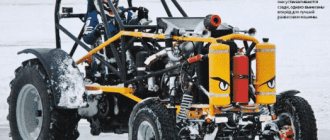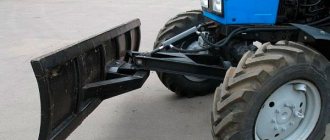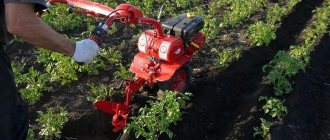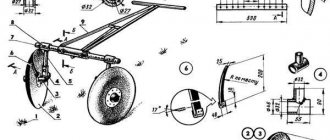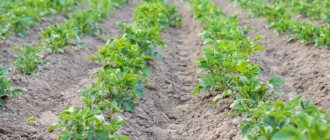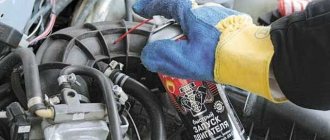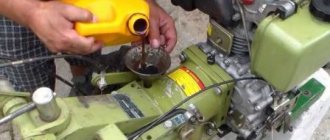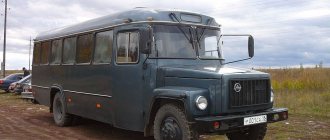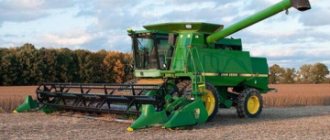For every owner of a personal plot, the most important task in the summer for growing a rich harvest is getting rid of weeds. The latest developments in the field of technical tools for gardening have allowed site owners to convert highly specialized units into universal devices. And this greatly facilitated the daily work of gardeners. Weeding potatoes with a trimmer makes it possible to carry out this agrotechnical activity without much physical effort.
Weeding trimmer attachments
For work, it is recommended to use a factory-made cultivator attachment. This is both easier and cheaper than making the device yourself. When selecting, it is recommended that you first take your trimmer and measure:
- rod diameter;
- number of splines on the shaft.
This information will allow you to choose the right nozzle. Typically, the description of the nozzles indicates the outer diameter of the rod - 26 or 28 mm and the number of splines on the shaft - 7, 9, or the cross-sectional shape of the end - square. To accurately select the right size, you should also measure the diameter of the shaft itself - they also differ in size, there are shafts with a diameter of 7, 8 and 9 mm.
If you are using a branded tool from well-known world brands, and not Chinese consumer goods, then it is better to order a branded attachment. This will extend the life of both the attachment and the brush cutter. In Moscow, for example, it is worth visiting branded stores, where professionals will select the nozzle; here you can also consult on the procedure for servicing the units.
To work on small areas, a regular disc cutter will be sufficient, but for large areas it is better to use reciprocating and drum cutters.
It is recommended to sharpen the cutters before each use.
When selecting a working tool, you need to focus on the dimensions recommended by the manufacturers. The hand will not be able to hold the blades that are too large, and the blades that are too small will not cope with the task. If you can select several sets of cutters for a cultivator, then you should consider purchasing cutters of different diameters - this will allow you to choose a tool for each specific type of task.
Why is a trimmer the best choice for your garden?
If you do not have a lawn that is smooth in all respects, and you need to deal with dense thickets, then a wheeled lawn mower is not suitable for you. In a country house where there is a vegetable garden, the surface of the plot is usually far from smooth. In this case, a trimmer is the most ideal option for cutting the lawn. And it's very simple to explain:
- It is very convenient for them to cultivate narrow areas between flower beds and along paths;
- It is perfect for mowing overgrowth along the fence and narrow openings;
- It is agile and easy to control;
- It is easy to carry from place to place.
Of course, if you need to mow large areas or don’t want to waste time, you can buy a robotic lawn mower that will independently control the weed growth. But although such a device is quite convenient, it will not cope with very lumpy surfaces.
A trimmer is the best tool for working in the garden
The trimmer is ideal for hard-to-reach places where a lawn mower cannot reach. In addition, when using a device with a cord, it is not scary to mow directly along a fence or building, as the blade may break. The fishing line will only be used up a little faster when colliding with solid objects.
But which trimmer is better to buy for your dacha, gasoline or electric? And with what engine location, top or bottom? Let's take a look at the details and choose the best trimmer for gardening.
Is it worth making a cultivator attachment yourself?
The technology for caring for vegetation will also change: first, use a knife attachment to walk through the beds, cutting off the grass, and only then use a cultivator attachment.
Having decided to make your own cultivator attachment for the trimmer, you should first evaluate the following:
The design of the output section of the boom: if it is a flexible shaft, then you will have to forget about the cultivator: it will not withstand the constantly changing amplitude of torques. The cardan transmission is more functional, and the most successful design is considered to be a multi-slotted rod, and a straight one, not a curved one. Drive power: If it is less than 1000W, the motor will overheat and the cultivation performance will drop sharply. Fuel tank volume: energy consumption will increase significantly, since the cultivator attachment will have to be made from scrap materials. Therefore, the tank must contain at least 1 liter of fuel. Handle design. Ergonomics experts believe that the most comfortable is the T-shaped handle, which provides the most accurate and reliable direction. The J-shaped handle common in some models makes it difficult to hold a gasoline trimmer with a cultivator attachment.
If the existing trimmer meets the listed requirements, and its owner has sufficient experience in performing such work, then it is quite possible to make a disk attachment with your own hands. As for gear-type nozzles, making them yourself is very labor-intensive and will not provide the desired quality.
Is it possible to make such a nozzle with your own hands?
It is not recommended to make a weeding attachment by hand, since it is difficult to select its width and the diameter of the cutters in such a way that the trimmer motor will not be damaged. But the price factor has a great influence on summer residents.
Craftsmen offer options for making attachments with your own hands.
Necessary materials:
- metal sheet 5 mm thick;
- nails;
- welding machine;
- metal cutter;
- fittings
Stages of manufacturing a three-bladed nozzle:
- Take a sheet of metal.
- Draw circles with a diameter of 32, 22 and 11 cm.
- Cut them along the contour and make holes for the working shaft in the center of each circle.
- Take the reinforcement and weld the discs at a distance of 1-2 cm.
- Take nails and weld them to the discs.
- It turns out to be an excellent homemade hedgehog attachment.
When working with homemade working parts, be sure to use a protective cover on the trimmer.
Do-it-yourself universal cultivator from a brush cutter
Features of the nozzle
Any cultivator attachment for a trimmer significantly increases the weight of the entire device assembly (by at least 5...6 kg). Therefore, not everyone can work with such a tool for a long time. It is also necessary to include mechanical limitations on the power of the trimmer drive into the calculation. If the engine is designed for a power of no more than 1500 W, then the cultivator can only cultivate regularly loosened soil, or limit itself to hilling breasts, potato bushes, etc.
Since the drive of gasoline trimmers is located behind the operator, and the drive rod is quite long, vibrations constantly occur during the cultivation process. Their size is determined by both the length of the rod and the changing load on the disks or cutters. These vibrations are transmitted through the shoulder strap to the user’s hands, so it is not always convenient to operate the trimmer power button and hold a rather capacious unit. Therefore, long-term soil cultivation using a cultivator attachment is unsafe for health.
But it’s not all bad: the mobility of a gasoline trimmer makes it easy to cultivate the soil between rows, and the absence of wheels on a mounted cultivator does not damage the plants in the beds.
The cultivator attachment “does not like” compacted soil, and when first introduced into such soil, the boom is abruptly thrown back. Therefore, disc cultivators are equipped with a safety guard (toothed cutters are more likely to bend than break, although even in this case a low protective shield on the leg side would be helpful). The presence of a safety screen impairs the visibility of those working with the cultivator.
https://youtube.com/watch?v=lnrCg1_b3t4%3F
What to weed with?
At the moment, there are various devices for weeding vegetables. It could be:
Modern man does not want to waste time and comes up with newer devices for the shelf. These include a walk-behind tractor. Makes work several times easier. This will be especially noted by the person who planted root crops under a shovel.
Walk-behind tractor
A special device designed for soil cultivation. Weeding potatoes with a walk-behind tractor is carried out using paws or a weeder. The most commonly used are paws. They are fixed on holders, adjusted to the size of the row spacing.
They should overlap each other slightly. When attaching the paws, you need to place them so that one is in front of the other. This placement prevents cut plants from clogging the tool. Experienced specialists know how to make them at home.
Paws are a special device for weeding. They can be one-sided, two-sided or lancet. Depending on the installation, it processes the row on one or both sides. With the help of a walk-behind tractor, it is easy to weed potatoes, since the device has high productivity.
As a rule, walk-behind tractors are used on farms.
Cultivator
Growing potatoes is a labor-intensive process that requires effort and time. Weeding potatoes is one of the important stages of growing. To facilitate the process of removing weeds, use a cultivator. The device can be manual, electric, or equipped with a gasoline engine.
You can also remove parasitic plants from the garden bed manually. This is a real godsend for older gardeners who suffer from arthrosis. For weeding potatoes, you buy the tool in the store or make it yourself. A cultivator removes plants along with their root system.
The technique of use is as follows. The tool is screwed completely into the soil, the entire length of the teeth should go into the ground. Then, in one motion, they lift it up along with the pulled out weed. Most suitable for processing row spacing.
Types of attachments for cultivators
To cultivate beds, cultivators equipped with a pair of knives are most often used. They are located at an angle of 45 degrees to each other. They do not miss a single plant or device, which, instead of knives, is equipped with small pitchforks with teeth. To make it easier to operate such a weapon, wheels are installed on them.
The farmer pushes it, pressing down on the soil. Thus, labor productivity increases.
Weeding potatoes with hedgehogs is a convenient way to get rid of parasitic plants and at the same time hill up the garden bed. Hedgehogs for weeding potatoes are a structure made of two cones. Both cones have 3 wheels, the material of which is metal. All differ in size, as they have different diameters to make work easier.
Sharp spikes are welded onto metal wheels. Before work, potato weeding hedgehogs are placed on the cultivator frame. As the wheel rotates, the spikes pull out weeds and hill up the beds. The use of hedgehogs in this case increases labor productivity.
This device was also improved by providing it with a motor. After this, using the motor cultivator became even more convenient. It makes it easier to process the crop. Using a motor allows the mini-device to make work in the garden easier.
Features of operation
Taking into account the capabilities of the trimmer and the attachment itself, work with the attachment is carried out before the period when the weeds have not yet grown and become stronger. Thus, the user’s work will be more efficient, because it is easier to cut short grass than to deal with coarse and thick stems. Timely loosening of the soil using a cultivator attachment will contribute to the accelerated growth and strengthening of planted crops and, as a result, high yields.
It is important to securely attach the attachment itself to the gasoline trimmer. It is important to take into account the fact that not every gardener can work with a brush cutter with a cultivator attachment, the reason for which is the weight of the scythe and attachment
If the engine of the unit is not designed for a power of more than 1500 W, this attachment can only be used as a ripper or a light hiller. It is important to understand that the attachment for cultivating soil using a gas mower in no way replaces the unit for weeding, plowing and hilling. This is a mini device for small purposes.
Knives rotating during operation are quite dangerous, and therefore you must work with a gasoline trimmer with extreme caution. Do not attempt to clear weed blades while the device is on. This can only be done when the engine is completely stopped. Do not grab knives with your hands or try to block them. The device must be inspected in a timely manner, eliminating breakdowns and worn parts.
You need to refuel the unit outside
It is important to ensure that there is no oil or fuel leakage. Do not allow the engine to overheat
During operation, the operator must stay away from rotating elements, since the cutters can damage limbs. Before starting work, you need to inspect the area of future processing and rid it of solid objects. For example, it is advisable to get rid of stones that can cause the cutters to stop or even break.
You can learn more about the cultivator attachment for a gasoline trimmer in the video below.
Is it possible to weed potatoes during flowering?
Regarding this issue, experienced agronomists and amateur gardeners are divided into two camps: some believe that potatoes should under no circumstances be overgrown with weeds even during potato flowering, others believe that at this stage overgrowing potatoes with weeds will no longer harm the crop, so weeds You can no longer weed, but mow along with the tops when harvesting.
At the same time, everyone is unanimous in the opinion that weeding potatoes during flowering will not harm them. First of all, this will allow you to keep the beds clean until harvest. In addition, when weeding, the soil is simultaneously loosened and saturated with oxygen. Since potatoes love loose soil and oxygen, weeding potato bushes during flowering will only have a positive effect.
Interesting! Some gardeners talk about experiences where even unweeded potato beds produced excellent yields. At the same time, there are no clear conclusions about such a “technique” of cultivation and it is subject to further research.
Types and principle of operation of cultivators
The principle of operation of the cultivator is simple: the element that loosens the soil begins to work after the mechanical part of the device starts. Depending on the external size, engine power and performance, cultivators are divided into three types: light, medium and heavy equipment.
- Light equipment is used in small areas with soft soil (flower beds, greenhouses).
- Medium weight is used on clay soils.
- Heavy equipment refers to universal equipment. It can be used for any soil.
There are different types of cultivators: disc, rotary, tine and milling. In terms of operation, they can be: manual, electrically driven and gasoline-powered, as well as trailed, mounted, and process one or several rows.
When cultivating a plot of land, everyone chooses the model they need. The good thing about hand cultivators is that you can make them yourself with minimal cash outlay.
Advantages and disadvantages
Each cultivator, regardless of whether it is manual or electric, has its pros and cons.
- Hand cultivator. Easy to use and much more convenient than a shovel, compact. Doesn't put stress on the lower back. It loosens the soil well and does not spread roots throughout the area. But this technique cannot cope with unplowed land, as it has low productivity. It is best used in small areas such as flower beds or greenhouses.
- Electric cultivator. Lightweight and compact equipment, powered by mains. Easy to maintain. The only downside to this technology is the electrical cord. It can interfere during work, and due to its length, there is a limitation in the area to be processed. It has low power and low tillage depth. Not intended for attachments.
- Gasoline cultivator. Thanks to the attachments, it has many functions. It is not connected to electricity, so it can move around the entire site. Suitable for processing small areas. Weighs much more than electrical equipment. It is difficult to maintain and requires fuel to refill.
Advantages and disadvantages of use
Advantages of using a trimmer during weeding:
- speed of task completion;
- high quality weeding;
- copes well with young weeds;
- loosens and enriches the soil with oxygen;
- weeding with a trimmer refers to organic farming;
- possibility of weeding in small areas;
- The nozzle is equipped with a protective casing.
Disadvantages of using a trimmer for weeding:
- the weight of the device increases;
- the cutter does not allow you to press the blades close to the soil;
- there is constant vibration and noise during operation;
- Long-term cultivation of land using this device is unsafe for health due to gasoline vapors.
The principle and effectiveness of the weeding method
Weeding as a treatment with a cultivator aims to destroy the weed by the method of exhaustion - after treatment, the plants need time to recover and gain the necessary strength. At this time, potatoes or other vegetable crops will be able, on the contrary, to continue their successful growth.
Weeding potatoes with a trimmer is usually carried out using three methods:
- mowing weeds with a mowing head or disc attachment;
- processing with a cultivator with a drum attachment;
- processing with a cultivator with saber or disk attachments.
Mowing is usually carried out when the weeds reach a height of 7-10 cm. In this case, only the part that is above the ground is mowed, and the roots remain intact. Usually, after this, rapid growth of green mass begins, so the effectiveness of such treatment is low.
When weeding with a trimmer is carried out using a drum cutter, the roots of the weeds are also treated. The big advantage of this method is that the top layer of soil fluffs up, and thus the air exchange of the soil increases. The effectiveness of this method is much higher than simple weeding by hand or working with a mechanical cultivator. The drum cutter allows you to loosen the soil to a depth of 3-5 cm.
When using saber or disk attachments, the efficiency increases even more - the processing depth increases to 5-7 cm. At the same time, plant roots, as well as the green mass of weeds, are repeatedly ground, which contributes to the rapid decomposition of plant residues in the soil. After such weeding, repeated weeding is usually carried out at least 10-14 days later. True, there is one nuance that needs to be taken into account - when working with drum cutters, the width of the processed strip is about 30 cm, but when working with reciprocating or disk cutters, the width is no more than 15-20 cm.
Weeding potatoes with a trimmer
Lawn aerator attachment for lawn mowers - what is it and what is it used for
Owners of private houses will find a useful device such as a lawn aerator attachment for a trimmer. Its main purpose is to saturate the soil layer with air. This is done to improve the growth of lawn grass. The action of the aerator is absolutely safe for vegetation.
Aerator
Externally, the nozzle resembles a rake, but its main purpose is to restore the breathability of the soil to saturate the root system of plants with air. The device can also be used for uniform distribution of organic fertilizers.
The cost of the aerator is about 10 thousand rubles, which depends on the manufacturer.
Rules for weeding with a trimmer
The rules for growing potatoes provide for several operations - continuous cultivation until the potatoes have sprouted, weeding the rows, hilling the bushes.
For simple cultivation, drum cutters are used; for weeding, you can use disk, saber, or drum cutters. But for hilling it is better to make a stacked structure - make the internal cutters of a larger diameter, and the outer cutters of a smaller diameter. This design ensures ease of use of the tool when hilling under a bush.
Weeding rules are quite simple:
- a sunny day is chosen for work, so that the weeds dry out in the sun as quickly as possible;
- For protective equipment, you should wear goggles and a respirator, and for shoes, boots;
- when working, as well as when mowing grass, it is recommended to use a shoulder strap;
- weeding is carried out with a deepening of 1-1.5 cm, this is enough to loosen the top layer and increase gas exchange in the soil;
- It is recommended to weed the entire row spacing until the plants rise to a height of 10-15 cm;
- Weeding is done in a zigzag, the nozzle is first moved to the left, and then at an angle to the right. The next move to the left, taking over the next lane.
- Hilling is done to a depth of 10-12 cm, with the first movement being forward in the center of the row spacing, and after that, turning the nozzle left and right, a mound is formed near the bushes.
- It is recommended to select the operating mode with short breaks so that the trimmer has time to cool down;
- At the end of the work, the nozzle must be cleaned, unscrew the screws of the technological holes and add molybdenum grease to the gearbox.
How to weed potatoes with a trimmer
Following the rules for properly weeding potatoes with a trimmer will allow you to avoid mistakes and carry out the work quickly and easily:
- It is better to weed potatoes while wearing a respirator and safety glasses, since when the cutters rotate, dust and weed particles fly up.
- Treatment with a trimmer is carried out at least once every 14 days, since weeds that have not yet taken root are susceptible to it.
- The best time for weeding is early sunny morning.
- Simultaneously with getting rid of weeds, potato beds are loosened if the cutting elements are deepened by more than 1.5 cm.
- The lower the engine power, the more often you should take a break, giving it rest.
- Before work, the cutters are treated with silicone grease, and such weeding is not carried out on heavy soil.
- Trimmer attachments must be periodically treated with a disinfectant that will destroy pathogens.
- There should be no other people nearby when working.
Kinds
Depending on the type, the device may or may not have cutters. Based on this feature, it can be classified into gear or disk. Products of the first type are characterized by the presence of cutters, which are located on both sides of the drive shaft. The second options work using cutting discs. However, the presence or absence of cutters does not affect the functionality - cultivator attachments for a gasoline trimmer are purchased for loosening the soil.
The differences between varieties lie in the type of soil that the cultivator attachments themselves can handle. For example, gear-type varieties are lighter in weight, however, because of this they are not able to process difficult soil. Disc analogues can work not only with light soil. These nozzles are characterized by greater rigidity, they are stronger and more durable.
FAQ
If the trimmer engine heats up quickly and within 5-7 minutes there is literally boiling water, does this mean that the attachment is not doing its job?
Perhaps the reason is that the attachment is not able to remove thick thickets of weeds, which leads to increased workload. But boiling of a gasoline trimmer can also be caused by a lack of oil in gasoline. Check that the correct concentrations and proportions are selected before filling the tank.
Do you need to choose attachments based on the model name or are some of them suitable for trimmers of other brands?
Ask a salesperson who will help you make the right choice. The power of the simplest garden trimmer is not always enough to fully operate the cultivator attachment.
How often should you sharpen the blades on the weeder attachment?
As it becomes dull. If you use it quite often and process more than 10 acres per week, then it is better to sharpen them every 10-12 days using special equipment.
Top 5 best gas trimmer attachments for weeding
Before ordering a trimmer attachment, read the description and characteristics of the top designs. Study their advantages and disadvantages, value for money. Well-known manufacturers: Bosch, Echo, Elitech, Husqvarna, Patriot, Oleo-Mac, Stihl, etc. The best attachments for gasoline trimmers are:
- KAAZ Kat-MC250P for VSP255S;
- ECHO PAS-Tiller Cultivator for PAS-265ES;
- KR400MP MAKITA 195710-3;
- Oleo-Mac CULT;
- for TAC petrol mowers.
KAAZ Kat-MC250P for petrol mowers VSP255S (244G03)
Trimmer attachment KAAZ Kat-MC250P for VSP255S
The cultivator attachment for the VSP255S trimmer has a subsoiler, thanks to which you can change the plowing depth. Suitable for processing small gardens. Due to its compact size, the nozzle is suitable for cultivating soil cultivated around flowers in flower beds, loosening the soil around trees and in hard-to-reach places. It effectively fights weeds. More details:
- price: 9990 rub.;
- characteristics: suitable for Caiman VSP255S, knife material – high-strength steel, working width – 240 mm, depth – 360 mm, manufacturer – Kaaz (Japan);
- advantages: wide range of action, ability to adjust plowing depth, strength;
- cons: fits only on one trimmer model.
ECHO PAS-Tiller Cultivator for brush cutters PAS-265ES
ECHO PAS-Tiller Cultivator attachment for brush cutters PAS-265ES
This attachment was created specifically for the PAS-265ES brush cutter for the purpose of processing small areas, flower beds and lawns. It is compact, but not effective for weeding large areas. The design is characterized by good strength and durability. It can replace a whole range of working tools for the garden. Weeding will be quick and effective. Options:
- price: 17800 rub.
- characteristics: manufacturer – ECHO (Japan), compatibility – with PAS-265ES, gross weight – 3.36 kg;
- pros: compact, maneuverable, high quality workmanship, easy installation;
- cons: expensive, suitable for one brush cutter.
KR400MP MAKITA 195710-3
Nozzle KR400MP MAKITA 195710-3
The trimmer attachment from the Japanese manufacturer will greatly simplify the care of your summer cottage, small garden or garden. It is also well suited for landscaping lawns and flower beds. Weighs slightly less than other analogues for weeding. The design is generally reliable, made of metal. The cutting element is cutters. Options:
- price: 17160 rub.
- characteristics: tool model – EX2650LH, DUX60Z, width – 16 cm, cutter diameter – 23.2 cm, manufacturer – MAKITA (Japan);
- pros: good efficiency, high reliability, ideal for weeding small areas;
- cons: high cost.
Oleo-Mac CULT
Oleo-Mac CULT nozzle
A cultivating addition to the trimmer, designed for processing small vegetable gardens, beds, flower beds and even greenhouses. The tool has the ability to adjust the plowing depth, because it is equipped with a subsoiler. The knives are made of high-strength steel, which can indicate their reliability and durability. Detailed parameters:
- price: 12990 rub.
- characteristics: brand – Oleo-Mac (Italy), knife material – steel, cutter width – 200 mm, weight – 6 kg, suitable for Oleo-Mac 740T, 746T, 753T, 755 Master models;
- pros: you can adjust the plowing depth, durable knives, good efficiency in small areas, wide cutters;
- Cons: heavy, slightly larger than analogues.
Attachment for TAC lawn mowers (shaft – 7 splines, rod 26 mm)
Attachment for TAC trimmers
This is a weeding trimmer attachment that thoroughly digs up the soil, facilitating the penetration of moisture and nutrients and saturating it with oxygen. The device is securely attached to the trimmer. In order to quickly and easily loosen the soil in a small area, the cultivator has rotating cutters. A protective shield, like other models, will help prevent debris from entering the operator. Detailed parameters:
- price: 7900 rub.;
- characteristics: manufacturer – Taiwan, power – gasoline engine, cutting element – knife, cutter diameter – 200 mm, passage width – 120–240 mm, rotation speed – up to 180 rpm, internal shaft – 7 splines, outer diameter rods – 28 mm, weight – 5 kg;
- pros: reasonable price, durable design, efficient, wide passage, quickly and easily loosens the soil;
- cons: heavier than analogues.
Trimmer belt - functions and selection
Some brush cutters are quite large in size and quite heavy, which significantly complicates their operation and transportation around the site. To make using tools more convenient, manufacturers equip them with belts. The main function of the latter is not only to increase the comfort when using the trimmer, but also to protect the trimmer from falls.
Despite the important functions of belts, they are still missing from some models of brush cutters. In such cases, equipment owners have to choose their own devices.
When purchasing them, you need to pay attention to the following factors:
- material – belts made from synthetics are considered the most reliable. There should be inserts and seals inside them that protect the operator’s skin from chafing;
- high-quality latch - many manufacturers save on this element. When choosing a belt, you need to check the condition of the latch by opening and closing it several times. If after 5-6 openings the latch opens with the same force as before, then this belt will last long enough;
- manufacturer - it is best to buy belts from well-known brands: Stihl, Makita, Husqvarna or Champion.
A backpack trimmer has proven to be a good option in practice - this is equipment in which the engine, carburetor, as well as other spare parts and structural mechanisms are placed in a backpack. In this case, the flexible shaft, gearbox and cutting elements are placed in front of the operator.
The backpack type brush cutter is distinguished by its lightness and small dimensions. In addition, it is much easier to carry around the site.
How to choose?
When buying a cultivator attachment for a gas trimmer, in addition to the power of the gas trimmer engine, they rely on several factors. These are the processing width, weight, cutter diameter and number of revolutions per minute. On average, the diameter of the cutters can be 20 cm, the number of revolutions can be 180.
As for the design of the boom, it is useless to buy a cultivation attachment for a flexible shaft; it will damage the unit quite quickly. The ideal option would be to purchase a product with a multi-slotted rod paired with a cardan drive. Such a unit will perform more efficiently and be reliable.
To prevent the engine from overheating, it is important that the power is at least 1000 W, otherwise labor productivity will decrease
Trimmer attachment Support wheel
The new support wheel for the trimmer makes it much easier to work with the trimmer with different attachments. This attachment can be attached to the trimmer shaft in a variety of positions, providing versatility and adaptability. The support wheel allows you to maintain the same cutting height, as well as the same cutting depth and width when using the edger on flower beds and garden paths. The attachment is equipped with two support wheels for working as an edger or one rotary wheel for working as a trimmer. The support wheel can also be used with a blower or brush.
What devices will be most effective?
- Fishing line. With its help you can quickly mow down weeds. At the same time, they grow back slowly.
- Three bladed knife. A metal device is used on instruments with a straight rod. For trimmers with a curved shaft, a plastic knife is used.
- Cultivator attachment. It is similar to conventional cultivating tools and is easy to put on the scythe. The size and diameter of the nozzle depends on the performance of the brush cutter. You can usually find out about these characteristics in the instructions for the nozzle.
Article on the topic: Nitrophoska for potatoes: instructions, time and application rates
Pros and cons of the method
Weeding a garden with a trimmer, and especially the area where potatoes grow, has its own characteristics and specifics.
First of all, you need to pay attention to the fact that you need to choose the right tool for the job. It is preferable to choose powerful four-stroke engines as a working engine.
Such brush cutters have lower gas consumption and greater productivity compared to two-stroke ones. For two-stroke engines, the recommendations boil down to choosing a higher engine power; the more powerful the engine, the more efficient the work.
Weeding potatoes, unlike making hay or mowing the lawn, is a more labor-intensive process, so you need to be prepared for the fact that after work not only your back, but also your arms and legs will hurt. The fact is that during work you will have to keep the nozzle suspended, preventing the lugs from completely burying themselves in the ground. In addition, you will have to move the unit along the surface from right to left, which also requires significant effort.
But from an economic point of view, such potato weeding will be much more effective than manual weeding - in a season, using a cultivator, you can cultivate a much larger area than with your hands. In this case, repeated processing will be required after a longer period of time.
Alas, there is also a minus. This is a lot of gas mileage. In normal mode, gasoline consumption is usually 0.44-0.92 liters of combustible mixture per 1 hour of operation of the unit, depending on the design and type of engine. With the device installed, this figure increases by approximately 35-40%. So you have to choose either saving time and quality of work or saving money.
Cultivator attachment in action
Boat motor from a gasoline trimmer
Fishermen who have a boat, but have not yet had time to purchase a motor, can take advantage of the rational offer from modern manufacturers of gas-powered tools
Attention should be paid to the attachment of the outboard motor for the lawn mower. The equipment is suitable for propelling wooden, rubber and even metal boats, but it all depends on the power of the motor of the trimmer used
boat propeller
The attachment is also called a “boat propeller”, as it is a rod with a fixed three-blade propeller, which is driven by a trimmer motor. The gas of the tool is output to the handle, which also serves as a steering wheel. Only the motor is used from the trimmer, so the rod is completely detachable. The internal combustion engine is attached to the nozzle using four bolts. The device with the engine is fixed to the boat using a built-in clamp.
Naturally, a boat with such a drive will not develop high speeds, but it is quite suitable for going out into open water to a fishing spot. The maximum speed developed by the drive, consisting of a boat propeller attachment and a trimmer motor, is up to 20 km per hour, which depends not only on the power, but also on the load of the vessel. Fuel consumption does not exceed 1 liter per hour, so the equipment is recommended to all fishermen as an alternative to expensive outboard motors.
This is interesting! For metal boats, it is better not to use such a drive, since due to heavy loads, rapid overheating of the internal combustion engine and failure of parts cannot be ruled out.
Non-existent attachments
On the Internet you can find several exotic attachments that are physically difficult to use on a lawn mower. Let's figure out where the truth is and where these rumors come from.
Drill attachment
This attachment is confused with a motor drill. In fact, it is an independent tool, the gasoline engine of which is similar to the engine of a lawn mower. This was the reason for the untrue rumors about the super-nozzle. In fact, such an attachment would require complete disassembly of the trimmer, which is ineffective.
A gasoline drill is a useful tool that allows you to work in the absence of electricity. The powerful drive increases the productivity of the drill. The tool is characterized by durability and increased reliability. A distinctive advantage is the colossal torque (due to the presence of a reduction gearbox with a gear ratio of 17:1).
snow blower
Such designs are not commercially available, primarily because removing snow with a brush cutter is inconvenient. The snow auger is heavy and difficult to hold in front of you. A small and light auger will have low productivity. There are homemade models created by folk craftsmen, but their effectiveness can be judged from the video below. An ordinary shovel will cope with this volume faster.
To remove snow, you need to use specialized tools, which are characterized by better performance and ease of operation. A special bell sets the direction of snow ejection, which allows you to clear paths, parking lots or backyards more efficiently and quickly.
The good thing about the listed tools and accessories is that they are suitable for most modern trimmers. They are affordable and easy to use, and, most importantly, they make caring for your garden easy and enjoyable.
Method of growing potatoes without weeding
Particularly radical adherents of green farming argue that potatoes should not be weeded at all without damaging the future harvest. At the same time, this method was invented back in the 19th century and is actively used by some agronomists. This method also involves weed control, but it comes in a different form.
To grow potatoes without weeding, the soil is prepared in the fall. To do this, it should be cleared of weeds in advance, dug up or plowed, but without loosening, so that the soil can breathe better. After this, humus mixed with ash, urea, nitrogen and potassium fertilizers, which are destructive to Colorado potato beetles and other pests, is added to the soil. The top of the area is covered with a thick layer of straw.
During the autumn-winter, the straw will rot, preventing pests and weeds from penetrating the soil, forming a layer of natural mulch. Sprouted potatoes are planted without removing this mulch, fertilizing the holes with pre-prepared humus.
After germination, a layer of mulch prevents the appearance of weeds, maintains a favorable soil temperature and retains moisture.
Important! Instead of straw, you can use green manure (alfalfa, rapeseed, peas and other legumes), which are sown in advance in August. By September-October they form a fairly tall grass cover, which is mowed for the winter. Thus, mulch is obtained from hay grown in the same area.
Thus, weeding potatoes is an integral part of agricultural technology for growing potatoes, although there are growing methods that do not involve weeding. There are also many devices for weeding potatoes - from traditional manual ones to mechanized ones. Undoubtedly, the use of modern mechanized tools greatly facilitates and speeds up the process of weeding potatoes.
